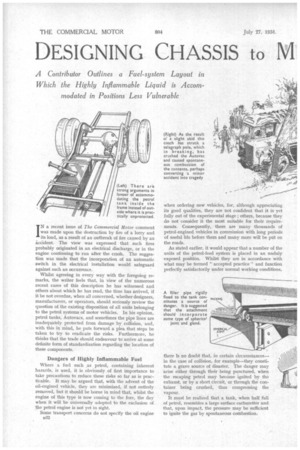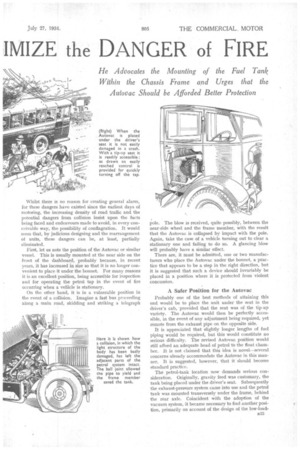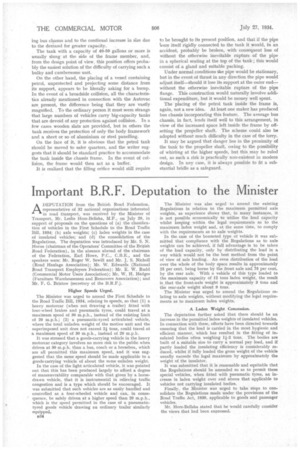DESIGNING CHASSIS to M IMIZE the DANGER of FIRE
Page 50

Page 51

Page 52

If you've noticed an error in this article please click here to report it so we can fix it.
I
' N a recent issue of The Commercial Motor comment
was made upon the destruction by fire of a lorry and its load, as a result of an outbreak of fire caused by an iccident. The view was expressed that such fires probably originated in an electrical discharge, or in the engine continuing to run after the crash. The suggestion was made that the incorporation of an automatic switch in the electrical installation would safeguard against such an occurrence.
. Whilst agreeing in every way with the foregoing remarks, the writer feels that, in view of the numerous recent cases of this description he has witnessed and others about which he has read, the time has arrived, if it be not overdue, when all concerned, whether designers, manufacturers, or operators, should seriously review the question of the existing disposition of all units belonging to the petrol systems of motor vehicles. In his opinion, petrol tanks, Autovacs, and sometimes the pipe lines are inadequately protected from damage by collision, and, with this in mind, he puts forward a plea that steps be taken to try to eradicate the risks. Furthermore, he thinks that the trade should endeavour to arrive at some definite form of standardization regarding the location of these components.
Dangers of Highly Inflammable Fuel
Where a fuel such ,as petrol, containing inherent hazards, is used, it is obviously of first importance to take precautions to reduce these risks so far as is practicable. It may be argued that, with the advent of the oil-engined vehicle, they are minimized, if not entirely removed, but it should be borne in mind that, whilst the engine of this type is now coming to the fore, the day when it will be universally adopted to the exclusion of the petrol engine is not yet in sight.
Some transport concerns do not specify the oil engine B32
when ordering new vehicles, for, although appreciating
its good qualities, they are not confident that it is yet fully out of the experimental stage ; others, because they do not consider it the most suitable for their require ments. Consequently, there are many thousands of petrol enginecl vehicles in commission with long periods of useful life before them and many more will be put on the roads.
As stated earlier, it would appear that a number of the units of the petrol-feed system is placed in an unduly exposed position. Whilst they are in accordance with what may be termed "accepted practice" and function perfectly satisfactorily under normal working conditions,
there Is no doubt that, in certain Circumstances— in the case of collision, for example—they constitute a grave source of disaster. The danger may arise either through their being punctured, when the escaping petrol may becOme ignited by the exhaust, or by a short circuit, or through the container being crushed, thus compressing the vapour.
It must be realized that a tank, when half full of petrol, resembles a large surface carburetter and that, upon impact, the pressure may be sufficient to ignite the gas by spontaneous combustion. Whilst there is no reason for creating general alarm, for these dangers have existed since the earliest days of motoring, the increasing density of road traffic and the potential dangers from collision insist upon the facts being faced and endeavours made to avoid, in every conceivable way, the possibility of conflagration. It would seem that, by judicious designing and the rearrangement of units, these dangers can be, at least, partially eliminated.
First, let us note the position of the Autovac or similar vessel. This is usually mounted at the near side on the front of the dashboard, probably because, in recent years, it has increased in size so that it is no longer convenient to place it under the bonnet. For many reasons it is an excellent position, being accessible for inspection and for operating the petrol tap in the event of fire occurring when a vehicle is stationary.
On the other hand, it is in a vulnerable position in the event of a collision. Imagine a fast bus proceeding along a main road, skidding and striking a telegraph
pole. The blow is received, quite possibly, between the near-side wheel and the frame member, with the result that the Autovac is collapsed by impact with the pole. Again, take the case of a vehicle turning out to clear a stationary one and failing to do so. A glancing blow will probably have a similar effect.
There are, it must be admitted, one or two manufacturers who place the Autovac under the bonnet, a practice that appears to be a step in the right direction, but it is suggested that such a device should invariably be placed in a position where it is protected from violent concussion.
A Safer Position for the Autovac
Probably one of the best methods of attaining this end would be to place the unit under the seat in the driver's cab, provided that the seat was of the tip-up variety. The Autovac would then be perfectly accessible, in the event of any adjustment being required, yet remote from the exhaust pipe on the opposite side.
It is appreciated that slightly longer lengths of fuel piping would be required, but this would constitute no serious difficulty. The revised Autovac position would still afford an adequate head of petrol to the float chamber. It is not claimed that this idea is novel—several concerns already accommodate the Autovac in this manner. It is suggested, however, that it should become standard practice.
The petrol-tank location now demands serious consideration. Originally, gravity feed was customary, the tank being placed under the driver's seat. Subsequently the exhaust-pressure system came into use and the petrol tank was mounted transversely under the frame, behind the rear axle. Coincident with the adoption of the vacuum system, it became necessary to find another position, primarily on account of the design of the low-load ing bus chassis and to the continual increase in size due to the demand for greater capacity.
The tank with a capacity of 40-50 gallons or more is usually slungat the side of the frame member, and, from the design point of view, this position offers probably the easiest solution of the difficulty of carrying such a bulky and cumbersome unit.
On the other hand, the placing of a vessel containing petrol, unprotected and projecting some distance from its support, appears to be literally asking for a bump. In the event of a broadside collision, all the characteristics already mentioned in connection with the Autovac are present, the difference being that they are vastly magnified. To the ordinary person it must seem strange that large numbers of vehicles carry big-capacity tanks that are devoid of any protection against collision. In a few cases wooden slats are provided, but in others the tank receives the protection of only the body framework and a sheet or so of aluminium or steel panelling.
On the face of it, it is obvious that the petrol tank should be moved to safer quarters, and the writer suggests that it should be standard practice to accommodate the tank inside the chassis frame. In the event of collision, the frame would then act as a buffer.
It is realized that the filling orifice would still require to be brought to its present position, and that if the pipe Were itself rigidly connected to the tank it would, in an accident, probably be broken, with consequent loss of without the otherwise inevitable rupture of the pipe in a spherical seating at the top of the tank ; this would consist of a gland and suitable packing.
Under normal conditions the pipe would be stationary, but in the event of thrust in any direction the pipe would adjust itself—should it lose its support at the outer end— without the otherwise inevitable rupture of the pipe flange. This construction would naturally involve additional expenditure, but it would be money well spent.
The placing of the petrol tank inside the frame is, again, not a new idea. At least one maker has produced bus chassis incorporating this feature. The average bus chassis, in fact, lends itself well to this arrangement, in view of the increased space left inside the frame by offsetting the propeller shaft. The scheme could also be adopted without much difficulty in the case of the lorry.
It may be argued that danger lies in the proximity of the tank to the propeller shaft, owing to the possibility of whirling at the higher speeds, but this may be ruled out, as such a risk is practically non-existent in modem design. In any case, it is always possible to fit a substantial bridle as a safeguard.




































































































